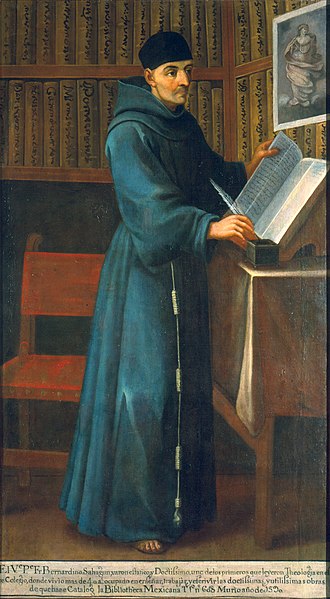The Florentine Codex is a 16th-century ethnographic research study in Mesoamerica by the Spanish Franciscan friar Bernardino de Sahagún. Sahagún originally titled it La Historia General de las Cosas de Nueva España. After a translation mistake, it was given the name Historia general de las Cosas de Nueva España. The best-preserved manuscript is commonly referred to as the Florentine Codex, as the codex is held in the Laurentian Library of Florence, Italy.
Page 51 of Book IX from the Florentine Codex. The text is in Nahuatl; World Digital Library.
Historia general de las Cosas de Nueva España (original from the Biblioteca Medicea Laurenziana)
An illustration of the "One Flower" ceremony, from the 16th-century Florentine Codex. The two drums are the teponaztli (foreground) and the huehuetl (background).
Aztec warriors as shown in the Florentine Codex
Bernardino de Sahagún was a Franciscan friar, missionary priest and pioneering ethnographer who participated in the Catholic evangelization of colonial New Spain. Born in Sahagún, Spain, in 1499, he journeyed to New Spain in 1529. He learned Nahuatl and spent more than 50 years in the study of Aztec beliefs, culture and history. Though he was primarily devoted to his missionary task, his extraordinary work documenting indigenous worldview and culture has earned him the title as “the first anthropologist." He also contributed to the description of Nahuatl, the imperial language of the Aztec Empire. He translated the Psalms, the Gospels, and a catechism into Nahuatl.
17th-century portrait of Sahagún
Fray Bernardino de Sahagún
Title page, Psalmodia Christiana, 1583
Aztec warriors as shown in the Florentine Codex.







